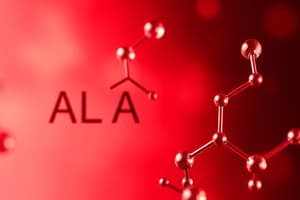Podcast
Questions and Answers
What is the primary product of the combustion reaction of alkanes?
What is the primary product of the combustion reaction of alkanes?
- Alkenes and alcohols
- Hydrogen gas and carbon monoxide
- Oxygen and salt
- Carbon dioxide and water (correct)
What type of reaction occurs when alkanes react with halogens?
What type of reaction occurs when alkanes react with halogens?
- Elimination
- Substitution (correct)
- Oxidation
- Addition
Under what conditions can alkanes undergo oxidation?
Under what conditions can alkanes undergo oxidation?
- Only during combustion
- In the presence of a catalyst without heat
- Only at room temperature
- When exposed to high temperatures (correct)
Which of the following describes the cracking process of alkanes?
Which of the following describes the cracking process of alkanes?
What is a common characteristic of alkanes regarding their chemical reactivity?
What is a common characteristic of alkanes regarding their chemical reactivity?
ما هي الصيغة العامة للألكانات؟
ما هي الصيغة العامة للألكانات؟
ما هو التفاعل الذي يتطلب وجود الأكسجين ويؤدي إلى إنتاج ثاني أكسيد الكربون والماء؟
ما هو التفاعل الذي يتطلب وجود الأكسجين ويؤدي إلى إنتاج ثاني أكسيد الكربون والماء؟
أي من الخيارات التالية يعبر عن المواد الناتجة من التفاعل الحراري لدرجة حرارة عالية؟
أي من الخيارات التالية يعبر عن المواد الناتجة من التفاعل الحراري لدرجة حرارة عالية؟
ما هي نوعية التفاعل الذي يحدث عندما يتم استبدال ذرة هيدروجين في الألكان بذرة هالوجين؟
ما هي نوعية التفاعل الذي يحدث عندما يتم استبدال ذرة هيدروجين في الألكان بذرة هالوجين؟
كيف يمكن أن تتغير تفاعلية الألكانات؟
كيف يمكن أن تتغير تفاعلية الألكانات؟
Flashcards are hidden until you start studying
Study Notes
الكيمياء العضوية
تفاعلات الألكانات
-
تعريف الألكانات:
- مركبات كيميائية تتكون فقط من الكربون والهيدروجين.
- صيغتها العامة: CnH2n+2.
-
الخصائص العامة للألكانات:
- غير قطبية، لذا فهي غير قابلة للذوبان في الماء.
- نقطة غليانها ونقطة انصهارها تزداد مع زيادة عدد ذرات الكربون.
أنواع تفاعلات الألكانات
-
تفاعل الاحتراق:
- الألكانات تحترق في وجود الأكسجين.
- الناتج: ثاني أكسيد الكربون والماء.
- مثال:
- C3H8 + 5 O2 → 3 CO2 + 4 H2O
-
التفاعل مع الهالوجينات (الهالوجينation):
- يتم في وجود الضوء أو الحرارة.
- تحدث عملية استبدال ذرات الهيدروجين بذرات الهالوجين.
- مثال:
- CH4 + Cl2 → CH3Cl + HCl
-
تفاعل الألكانات مع الأكسجين (أكسدة):
- الألكانات يمكن أن تُؤكسَد، مما يؤدي إلى تكوين الألكينات أو الكحولات.
- هذا التفاعل يتطلب شروط معينة مثل حرارة مرتفعة.
-
تفاعل التكسير (Cracking):
- تجزئة الألكانات الكبيرة إلى ألكانات أصغر.
- يمكن أن يحدث بشكل حراري أو بواسطة المحفزات.
- يُستخدم في صناعة الوقود.
-
التفاعل مع الأحماض:
- يمكن أن تتفاعل الألكانات مع الأحماض لإنتاج الأملاح.
- تفاعل نادر ويحتاج لشروط معينة.
ملاحظات هامة
- الألكانات بشكل عام غير نشطة كيميائياً مقارنةً بالمركبات العضوية الأخرى.
- التفاعلات تتطلب عادةً شروط معينة مثل الحرارة أو الضوء لتعزيز التفاعل.
Organic Chemistry
Alkanes Reactions
-
Definition of Alkanes:
- Chemical compounds composed solely of carbon and hydrogen.
- General formula: CnH2n+2.
-
General Properties of Alkanes:
- Non-polar, making them insoluble in water.
- Boiling and melting points increase with the addition of carbon atoms.
Types of Alkane Reactions
-
Combustion Reaction:
- Alkanes burn in the presence of oxygen.
- Products of combustion are carbon dioxide (CO2) and water (H2O).
- Example:
- C3H8 + 5 O2 → 3 CO2 + 4 H2O
-
Halogenation:
- Occurs in the presence of light or heat.
- Involves the substitution of hydrogen atoms with halogen atoms.
- Example:
- CH4 + Cl2 → CH3Cl + HCl
-
Oxidation Reaction:
- Alkanes can be oxidized to form alkenes or alcohols.
- Requires specific conditions, such as high temperatures.
-
Cracking:
- The process of breaking down larger alkanes into smaller alkanes.
- Can occur thermally or using catalysts.
- Utilized in the production of fuels.
-
Reaction with Acids:
- Alkanes can react with acids to produce salts.
- This reaction is rare and requires specific conditions.
Important Notes
- Alkanes are generally less reactive compared to other organic compounds.
- Reactions often necessitate specific conditions such as heat or light to proceed effectively.
Alkanes Reactions
- Definition of Alkanes:
- Saturated hydrocarbons with only single bonds between carbon atoms.
- General formula: CnH2n+2.
Types of Reactions
-
Combustion Reaction:
- Alkanes combust in the presence of oxygen.
- Produces carbon dioxide (CO2) and water (H2O).
- Example reaction: C3H8 + 5O2 → 3CO2 + 4H2O.
-
Halogenation:
- Involves the replacement of hydrogen atoms with halogens (F, Cl, Br, I).
- Requires heat or light to initiate.
- Example reaction: C4H10 + Cl2 → C4H9Cl + HCl.
-
Thermal Cracking:
- Heating alkanes at high temperatures causes bond breakage.
- Results in smaller hydrocarbons or other substances.
-
Reaction with Oxygen:
- Alkanes can react with oxygen at high temperatures.
- Produces carbon oxides and water.
Reaction Characteristics
- All reactions necessitate specific conditions such as heat, pressure, or the presence of catalysts.
- Alkanes are relatively stable and do not readily react under standard conditions.
Importance of Alkanes
- Serve as key energy sources.
- Play a significant role in the chemical industry for manufacturing plastics and rubber.
Substitution Reactions
- Occur when a hydrogen atom in an alkane is replaced by another atom, such as a halogen.
Reactivity Conditions
-
Reactivity of alkanes can increase under specific conditions, like elevated pressure or the use of catalysts.
-
Understanding alkane reactions is fundamental to organic chemistry and its practical applications.
Studying That Suits You
Use AI to generate personalized quizzes and flashcards to suit your learning preferences.




